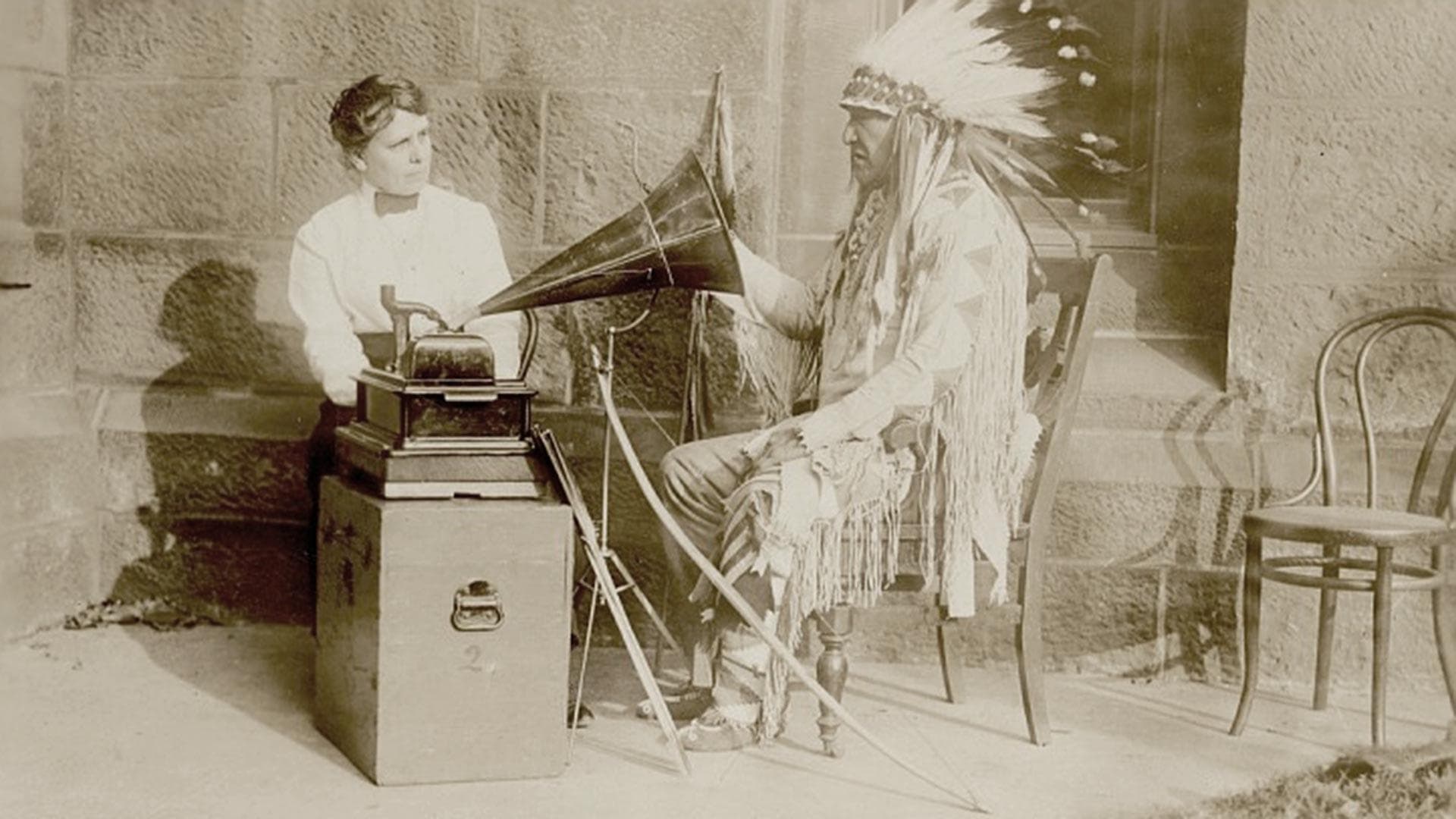Who Owns the Sounds and Images of Native People’s Pasts?
UMD Faculty Members Work to Reunite Native People With Archival Materials

In this 1916 photo, the chief of the Montana Blackfeet tribe interprets a song being played for him by ethnologist Frances Densmore. Two UMD faculty members are part of a new effort to repatriate photographs like these, as well as other archival items like audio recordings, drawings or field notebooks, back to the tribes that are the sources of the knowledge contained within them.
Photo courtesy of the National Anthropological Archives, Smithsonian Institution
In Palmer, Alaska, a 45-minute drive north from Anchorage, the Chickaloon people have all but lost their original language, Ahtna. The last known fluent speaker of the tribe’s native Western dialect died in 2010, and the remaining tribal citizens–who traditionally don’t count their members but are estimated to number about 350–speak an amalgam of Ahtna’s Western and Central dialects. Audio recordings of Western Ahtna exist, but many are kept in mainstream archives that don’t belong to the Chickaloon tribe.
Now, two University of Maryland faculty members are part of a new effort to bring those recordings, and other pieces of history, back to the Native people who lived the stories within them. Diana E. Marsh, assistant professor of archives and digital curation, and Eric Hung, an adjunct lecturer in the College of Information Studies, are part of the Society of American Archivists’ recently created Archival Repatriation Committee.
The committee will recommend “policies and best practices around physically returning archival documents to communities, which generally is not being done, or if it's being done, it's because a good-natured institution decides to ‘deaccession’ a collection,” said Marsh. “But there's not a lot of guidance on how to do that.”
With support from a new $98,000 grant from the Andrew W. Mellon Foundation, the committee will also develop an educational curriculum aimed at helping Native people navigate the process of requesting materials, covering the sometimes byzantine logistics that govern deaccessioning.
Archival materials can include photographs, audio recordings, drawings, a researcher’s field notebook, formulas for traditional medicine or video documentation. Often, these materials contain knowledge that a tribe considers sacred and that were taken to mainstream, historically white-led institutions without the Native people’s permission.
“A lot of these documents in archives either should never have been created or were created under duress,” said Hung, who is also executive director of the Music of Asian America Research Center. “A government official (or anthropologist) might have come in and recorded these things without consent.”
Under the Native American Graves Protection and Repatriation Act (NAGPRA), a federal law enacted in 1990, many institutions are required to return human remains, funerary objects and other cultural items to their rightful Native owners. But letters, photographs, recordings and other archival materials aren’t covered by NAGPRA, and under American copyright laws, “that notebook or that letter or that photograph is owned by the person who took it or documented it, and not by the person whose knowledge is in it,” said Marsh.
Archives around the world hold a staggering number of these materials, said Marsh. The LBJ Presidential Library in Austin, Texas, she said, has an estimated 18,000 linear feet (the standard archival measurement) of Native documents–roughly equivalent to 50 million individual items. “And that’s one archive in one institution,” said Marsh. “You can imagine the colonial collecting of, especially, the late 19th and early 20th centuries.”
Selena Ortega-Chiolero, the museum specialist for the Chickaloon Village Traditional Council in Palmer, feels an urgency to reunite the Chickaloon people with their ancestry. “Every day that we bring home a new audio recording of Western dialect, we’re getting a piece of that language back and helping to restore cultural traditions,” she said.
Native people have a visceral, emotional link to these materials, said Ortega-Chiolero. “I’ve worked in museums for many years–it’s very easy to become detached from the collections you manage,” she said. But she has seen how personal these items are to many.
“We had an elder who never saw a picture of her mother when she was young, because (her mother) was sent to a boarding school,” she said. During a digital repatriation from the Anchorage Museum, the elder saw for the first time an image of her mother as a girl.
“She was brought to tears,” Ortega-Chiolero said. “That’s the meaningful connection Indigenous people have with these materials.”